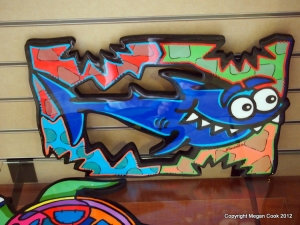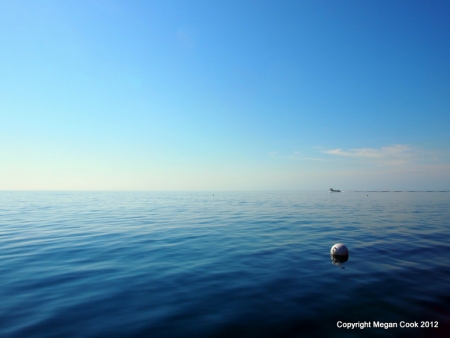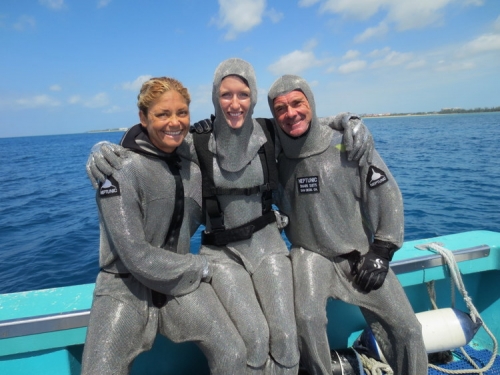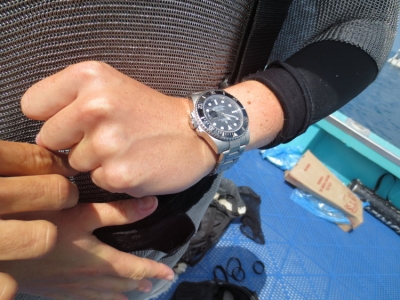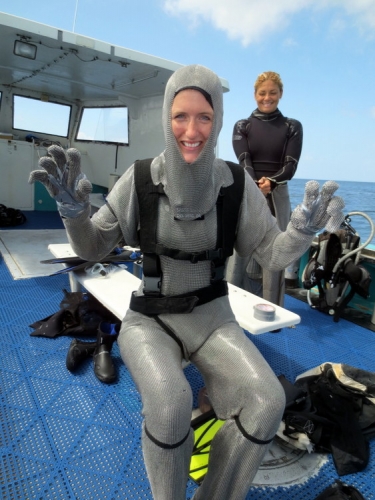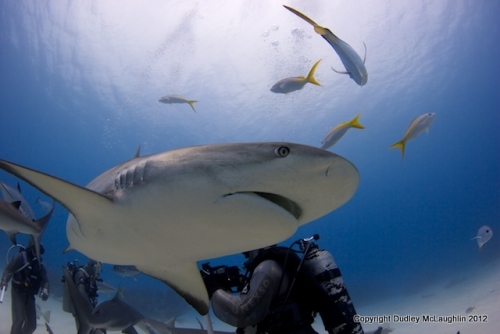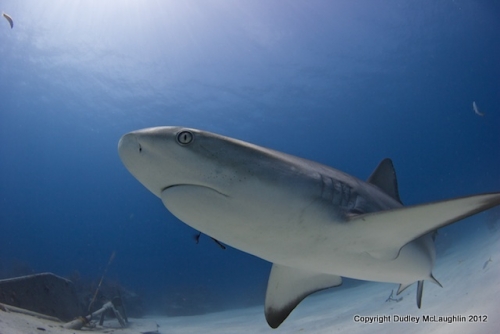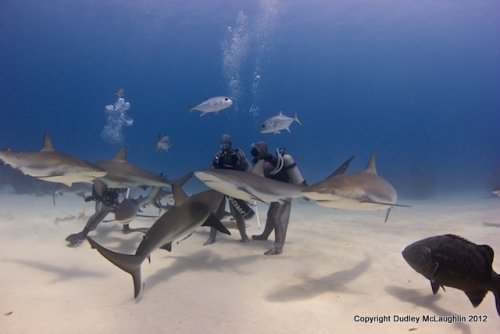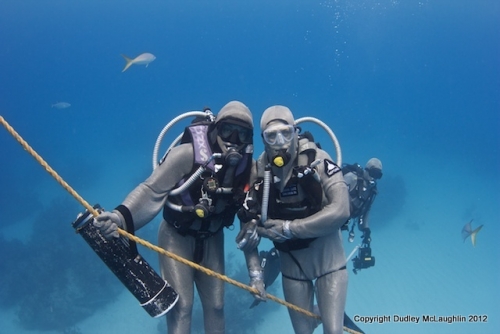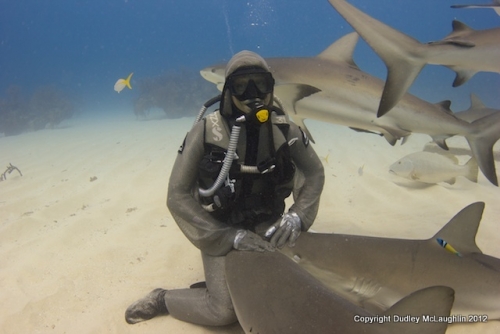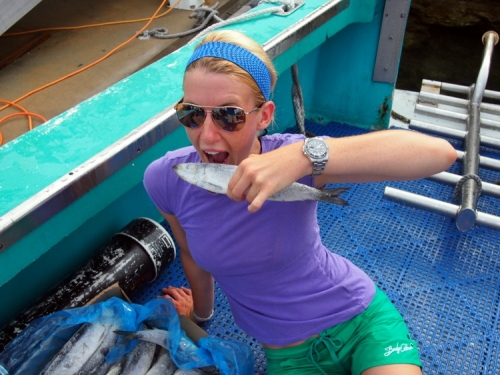Sharks are simply amazing! They are enigmatic, powerful creatures, misunderstood and too often undervalued. As a diver all my shark interactions have left me awestruck. Everyone loves a good shark story, and I love how these animals have the intrigue to bring people to the conservation discussion. I was eager to develop more personal experience with them and to build the background to help educate others. The opportunity to come to Grand Bahama and learn to hand-feed Caribbean reef sharks with Cristina Zenato was one I could not miss!
I was giddy suiting up in Neptunic chain mail for my first feed. The suit weighs almost 25 pounds and includes gloves, hood and sockies. The suits are worn not out of fear or apprehension but as a matter of respect for the animals we’re working with and respect for ourselves. World-class rock climbers still use ropes; it’s only right to wear gloves when handing snacks to sharks with sharp teeth.
Protect the Rolex!
Standing at Cristina’s side I felt calm and confident as the sharks came to investigate the feeding tube in our hands. 450 millions of years of evolution have transformed sharks into highly sensory, food-detecting missiles. Sharks could not be less interested in humans in the ocean. If you’re not a frozen herring, you’re not going to be eaten on this dive! Sharks are exquisite and I will never tire of watching them command presence in the ocean. Yet, it’s hard to see how they got a reputation as maniacal man-eaters when they bump around into one another, careen into the blunt end of the PVC feeder tube, or completely miss a bait that’s delivered a few seconds too early. It’s a public relations disaster that their toothy grins have been colored worthy of our fear rather than causal to our admiration and curiosity. (Thanks a lot Jaws!)
We have the power now to change the story!
Shark feeding like the observation dives run by UNEXSO gives people the chance to see sharks for themselves. Many enter the water with apprehension but climb up the ladder with new confidence and new appreciation.
While kneeling in the sand to watch sharks is special, feeding them hands-on is exhilarating! As I stepped backwards, the sharks would follow slowly cruising one after another with growing curiosity. I could reach out and greet each shark on their approach- both being polite introducing myself, and adjusting the timing of my feeder hand. When a shark entered the strike zone (V shaped space in front of the body, chin to hip height) all I needed to do was assertively snap a bait fish right on the tip of the shark’s nose. A successful feed is equal parts timing and bait placement! Much faster fish like horse-eye jacks, bar jacks, yellowtail snapper, dog snapper and an overly friendly black grouper named Peanut are also eager to sneak in a snack. My first few fish were placed too soon and the so called ‘ruthless eating machine’ sharks were no match for the quickness of their scaly friends.
It’s shark mating season in the Bahamas and the females have the fresh scars to prove it! The human equivalent injuries would easily put you in the ER. However, sharks arrived mellow for the feed with gashed faces, shredded pectorals, and notched bodies. Each shark was unique in their identifying features and attitude. It was hard not to pick favorites among the easy-feeders and docile personalities. Cristina teaches that by controlling the food, you control the sharks. This was especially clear on my second feed day when a very thin male joined the group about halfway through the dive. (Males will often lose their appetite during the mating season, as they’re entirely focused on chasing some tail). His hunger and insistent pursuit of every bait quickly ramped up the tone of the entire group. Calm passes escalated to tight turns with abrupt directional changes and sharks zooming in from every which way. I was beyond my preparedness, but all the urgency slipped away as soon as I dropped my hand from the feeder tube. Watching the group interact, I couldn’t help but wonder at all we still don’t know about these animals.
Cristina radiates love for sharks! Her eyes dance when discussing feeding theory. After 18 years of feeding experience she still has burgeoning curiosity to expand her understanding. Her conservation advocacy led to the thorough protection of sharks throughout the Bahamas. Underwater her passion is enveloping. Observing Cristina Zenato interact with sharks is a celebration of joy! Underwater with her ‘babies’ she is completely in her element and simultaneously in complete control and also in total flow with the movements all around her. Some of these sharks seek out her contact and Cristina’s touch will put them down to sleep. I had the chance to spend some of this special time with a very pregnant female during all three feedings. It’s magic to feel a large shark relax completely into your lap. The only movement is the rhythmic pressure of a strong jaw slacking into your leg as she force-ventilates her lungs. The relaxation is so complete you can lift the shark out of the sand and even balance it by the nose, in your palm.
I hope everyone with a love of sharks will take the time to share that passion with another person. I hope every diver with a fear of sharks will find an opportunity to expand their perspective with more education or an encounter like the UNEXSO shark dive. We’ve sadly given sharks a bad name and carelessly accepted their annihilation worldwide. It’s time for people, the rightful heirs to the ‘most dangerous creature in the sea’ title, to give sharks the re-branding, respect and protection they deserve. I am incredibly thankful for having a leader in conservation like Cristina Zenato to mentor us along the way. Thank you Cristina for bringing me to the Bahamas to fall in love with your sharks!
Watch me feeding sharks by hand!
